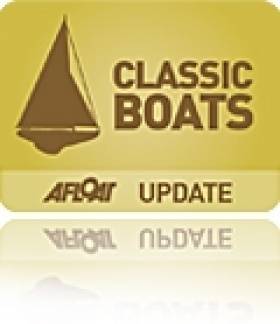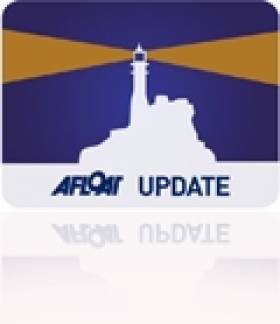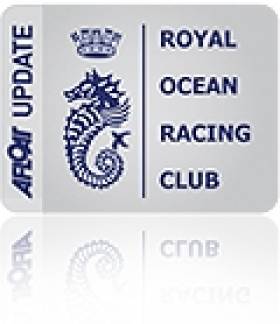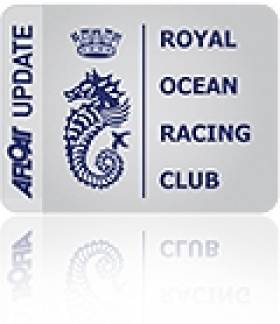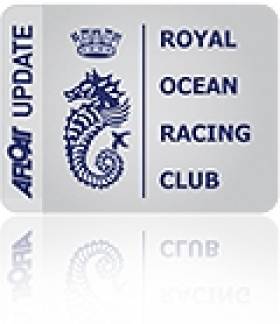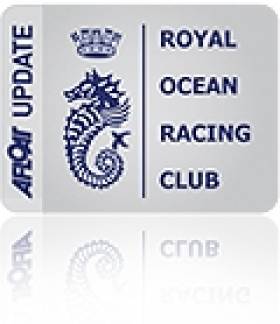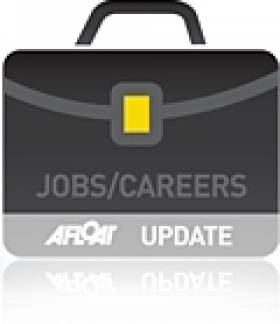Displaying items by tag: Royal Ocean Racing Club
In late June, one of sailing's most celebrated yachts will attempt to retrace the steps of her first, and most significant, victory. The 52-foot yawl Dorade, owned by Pam Levy and Matt Brooks (Tiburon, Calif.), will join 40 other boats competing in the Transatlantic Race 2015, which starts off Newport, R.I., and finishes off the southwestern coast of England. The race is organized by the Royal Yacht Squadron, the New York Yacht Club, the Royal Ocean Racing Club and the Storm Trysail Club.
Dorade, the seventh design from the Sparkman & Stephens design shop, was barely a year old when Olin and Rod Stephens and a crew of five sailors, including their father, started the 1931 Transatlantic Race off Newport, R.I., bound for Plymouth, England, 2,800 miles away. The trip took just over 17 days. Dorade was the first boat to finish and the race's overall champion on corrected time.
For the Stephens brothers, it was a transformative moment: in the coming years, they would each take on primary roles in the development of the sport. Dorade would make her own wake as well, stringing together an impressive, unparalleled for the time, series of victories on the East and West Coasts of the United States and in Europe.
After a series of significant re-fits, the boat was returned to original condition a few years ago by Levy and Brooks. Perfect for installation in a museum, many said, or for civilized day racing on the classic yacht circuit. But Levy and Brooks had other plans, namely to take the grand dame of ocean racing and repeat all of the races it won in the 1930s, including the Transatlantic Race, Newport Bermuda, Transpac and Rolex Fastnet.
"Everyone said we were proposing something that wasn't even in the realm of possibility," says Brooks of Dorade's four-race "Return to Blue Water" campaign. "Now we're coming up to the last two races—the Transatlantic Race 2015 and the Rolex Fastnet Race—and no one is questioning that the boat can do this." (Two years ago, Dorade won overall, corrected-time honors in the Transpac Race, beating a host of the latest carbon-fiber rockets; in the 2014 Newport Bermuda Race, she took first in her class under IRC.)
"Olin and Rod designed one hell of a boat," says Brooks. "I haven't met anyone who has sailed on her who doesn't learn to love her and trust her. She's very strong, very dependable; she just needs to be treated right. With wood boats, you're always in refit mode. But we're racing and sailing this boat 10,000 miles a year and she absolutely responds to that."
Winning silver with this historic yacht requires a comprehensive commitment. Brooks, Levy and their team are constantly maintaining and refining the yacht. This past winter, says Brooks, getting the bottom as smooth as possible and improving sail design were two areas of focus. Sailing the boat also requires a specific touch.
"If you are trying to muscle the boat into submission at the helm it is never going to happen," says Levy. "It will win. Having a balanced helm is critical."
For the Transatlantic Race 2015, Brooks and Levy have set as their first goal to beat the 17 days, one hour and 14 minutes it took Dorade to sail the course in 1931. Modern technology, including synthetic sail fabric, should give this year's team an edge; however, the course in 2015 is likely to be quite a bit longer than it was in 1931 due to an extreme number of icebergs in the Grand Banks of Newfoundland. The fleet will be required to sail east for a while before turning north for the Great Circle Route, which takes advantage of the earth's slightly oval shape to shave critical miles off the passage between the United States and Europe.
Whether or not they can match the boat's pace in 1931, Brooks and Levy couldn't be more excited about the prospect of this legendary yacht coming full circle to its first significant accomplishment.
"Of all the races we've done, the Transatlantic Race is the one that makes our heart go pitter patter, because it was Olin and Rod's first big victory, and it's what launched them in business in yacht design," says Levy. "We know from talking to Olin's family and from what he has written that he had a real affection for the boat. It gives us a lot of pleasure to do well with her."
Latest Maxis Racing For Fastnet Race Bragging Rights
#rorcfastnet – While it may not be the event's ultimate prize, the monohull battle for line honours in the Rolex Fastnet Race is always hotly contested, coming with considerable bragging rights. This year's race from Cowes to Plymouth via the Fastnet Rock, coinciding with the 90th anniversary of the event's organiser, the Royal Ocean Racing Club, will see the world's two very newest maxis jockeying for this prize. Both belong to American captains of industry and both were launched last autumn.
While it may not be the event's ultimate prize, the monohull battle for line honours in the Rolex Fastnet Race is always hotly contested, coming with considerable bragging rights. This year's race from Cowes to Plymouth via the Fastnet Rock, coinciding with the 90th anniversary of the event's organiser, the Royal Ocean Racing Club, will see the world's two very newest maxis jockeying for this prize. Both belong to American captains of industry and both were launched last autumn.
Favourite is the 100ft long Comanche owned by Jim and Kristy Hinze Clark. Clark, the Silicon Graphics and Netscape founder, has owned several high profile superyachts and the magnificent J-Class yacht, Hanuman, but his latest craft is a state of the art ocean racer designed by VPLP-Verdier, best known for their IMOCA 60 designs. In fact Comanche strongly resembles a scaled-up version of MACIF, winner of the last Vendee Globe, with a powerful hull, canting keel, twin daggerboards and rudders and numerous other go-faster features.
"The Rolex Fastnet Race is one of the goals for Comanche as one of the 'Great Races' around the globe," Clark explains. "Comanche was built to do two things: Win line honours and, if Mother Nature cooperates, try to break records. Let's hope that we succeed with both, but I know there will be lots of very strong competition!"
If Comanche is to break the Rolex Fastnet Race monohull race record, she will have to complete the 603 mile long course in less than 1 day 18 hours and 39 minutes - the time set by the Ian Walker-skippered VO70 Abu Dhabi Ocean Racing in 2011.
On paper, Comanche should have a clear run at the line honours title as she's 12ft longer than George David's latest maxi - Rambler 88, designed by Juan Kouyoumdjian. David observes: "No doubt Comanche is the bigger boat and rates accordingly. We're a little off Comanche's speed through the water, but it's too soon to tell after only four day races together." To date the boats have only lined up at Les Voiles de St Barts, but in July they will compete in the Transatlantic Race 2015, between Newport and the Lizard.
David is a great fan of the Rolex Fastnet Race: "It's a great blue water race - full of tradition and with a great turning mark at Fastnet Rock. We have done the race twice before and are delighted to be coming back." And this is despite his close shave with death during the 2011 race when the keel fell off his Rambler 100, leaving him and a group swimming in the Celtic Sea. Did he think twice about returning? "It's like being chucked off a horse. You get back on," David retorts.
In terms of their performance, America's Cup legend Brad Butterworth, who is sailing master and tactician on board, reckons Rambler's strengths versus Comanche are upwind and VMG downwind. This could bode well for the Rolex Fastnet Race's typically large windward-leeward course.
But to help her prospects, Rambler 88 is currently being fitted with a secret weapon in a Dynamic Stability Systems-style lifting foil. This retractable lateral foil, is deployed on the leeward side of the boat below the waterline (like a wing), to provide lift to leeward and a gain in righting moment, like having extra crew on the weather rail. This 'turbo charger' could reduce any deficit they might have against Comanche.
"They look pretty cool," says Butterworth. "I think that any time we are over 14 knots reaching they should make a difference. It might light the thing up. The boat certainly has a lot of sail area. It will be interesting."
While all eyes will be on the latest hardware, also in the mix will be Mike Slade's Farr 100, Leopard, the maxi which claimed line honours in the 2007 and 2009 Rolex Fastnet Races.
"It is an amazing fleet with Comanche and Rambler and a few Mini Maxis," observes Leopard's skipper Chris Sherlock. "It will be very tough to get on the podium - the best we can hope for against those two new boats will be third."
Owner Mike Slade intends to run a 'corinthian' campaign this season and will not be chartering the boat for the Rolex Fastnet Race. However on board will be the usual all-star cast, led by veteran America's Cup and round the world sailor, Paul Standbridge.
At present Leopard is in refit in Hamble Yacht Services. Among her upgrades for 2015 is a modernisation of her rig including the fitting of a deflector backstay arrangement in place of her multiple backstays and checkstays.
RORC IRC North Sea Race Won By Belgian MC34
#rorc – The 2014 RORC Season's Points Champion, Vincent Willemart and Eric Van Campenhout's Belgian MC34, Azawakh, was the overall winner of the 2015 North Sea Race, scoring the best corrected time under IRC, for the 182-mile race from Harwich to Scheveningen. Willem Schopman's Dutch Bashford Howison 36, Intention was second, just over a minute ahead, after time correction from Frans Rodenburg's Dutch First 40, Elke. Jan-friso Blacquiere's Maxfun 35, Blacq Magic was the overall winner of the ORC Class. Marcel Schuttelaar Dutch Maxi 1300, Ijsvogel was second and Willem de Jonge van Ellemeet's Dutch Dufour 40, Flying Dolphin was third in ORC overall.
74 yachts entered the 2015 North Sea Race, which was blessed with bright sunshine at the start. The Two-Handed fleet having been considerably swelled by the race being part of the inaugural Dutch Two-Handed National Championships. A moderate ten knots of breeze from the north provided a tactical beat against the tide up to Cork Sand Yacht Beacon via Outer Ridge before a gentle reach to the South Galloper Buoy. At dusk the wind speed reduced, providing very light and shifty conditions through the night. In the early hours of Saturday morning the leaders had made it to the most northerly part of the course, Smith's Knoll Buoy, and the wind started to fill in from the south west, giving exciting reaching conditions. As the fleet cracked sheets and hoisted downwind sails for a reaching across the North Sea, the final day of the offshore race provided fast thrilling racing for the fleet.
"We were very pleased to win and it was unexpected, the fleet was very strong." commented Eric Van Campenhout racing the overall winner, Azawakh. " The race had many different conditions, which suited us as we have good speed at many different wind strengths and wind directions. After last season, we felt that we needed to improve our performance in light winds and our experience with the boat and some modifications are definitely paying off. As we are Belgian it is nice to finish a race close to home and the North Sea Race has a beautiful start in the river and the course is very interesting with many different conditions and points of sail. We will be sailing the boat to Cowes this week to take part in the Myth of Malham, which is another great course and it is good practice for the start of the Fastnet.
John van der Starre & Robin Verhoef's Dutch J/111 Xcentric Ripper was the winner of the 18-strong IRC Two-Handed Class and winner of the ORC Two-Handed Class. This was the tenth North Sea Race for John van der Starre and by far the closest finish. After time correction, Xcentric Ripper won the class by four seconds from Erik Mayer-Martenson's Sun Fast 3200, Blizzard of Uz. Rob Craigie's Sun Fast 3600, Bellino was third.
" It was a tough but very nice race for us, with lots of reaching, perfect for a J/111, and winning the Two Handed Class, against very good opposition, was very satisfying." commented John van der Starre. "These days with AIS it is possible to see how well you are doing but you don't know how the weather will change for the boats behind you. In the delivery race to Harwich, Vuurschepen Race, the wind held up for the boats behind us but for the North Sea Race, that didn't happen. Myself and Robin have been racing together on the boat for four years, so we know our strengths and weaknesses. From the weather forecast we knew that we would have a point where there would be totally no wind on that first night but we know that would give us a good opportunity to gain on the opponents, we decided to stay more to the west, while our opposition went more to the east. The tactic really worked well for us with some good shifts. The wind was picking up, we were planing with about 12 knots of boat speed, it was fantastic but we did have one scary moment, as there were some large navigation marks which were not lit and we passed one by just 30 metres. When we got to Smith's Knoll Buoy we knew we were in a strong position but to win by just 4 seconds! One little mistake and we would have been second, the Two Handed Class at the Rolex Fastnet Race is going to be incredible but having won the class for the North Sea Race, 2015 is already a success for us."
The RORC Season's Points Championship continues Saturday 23 May with the Myth of Malham Race. The Bank Holiday Weekend race is 230 nautical miles from Cowes around the Eddystone Lighthouse and back to the Solent. Well over 100 yachts are expected to take part.
New Format Commodore's Cup Unveiled for 2016
#comodorescup – Irish defending champions of the Commodore's Cup will face a new format event next year following new rules unveiled this morning by London organisers, the Royal Ocean Racing Club. The Brewin Dolphin Commodores' Cup is the Royal Ocean Racing Club's (RORC) biennial flagship event for national teams with amateur crews. The international offshore regatta comprises a tough mix of inshore and offshore racing and is an intense seven-day programme that pits three-boat teams against one another to accrue overall team points.
Ireland has twice won the Cup in 2010 and 2014 both under the captaincy of Afloat Sailor of the Year Anthony O'Leary of Royal Cork Yacht Club. Read how Ireland won the Cup here.
For the next edition, The RORC Committee have agreed to a number of changes that will have a positive impact on the number of teams taking part in the event held at Cowes, Isle of Wight between 23 and 30 July 2016.
The first is the requirement of every team to have a small boat with a rating between 1.000 and 1.049. "Many teams in the last event believed that it was hard to be competitive without having three boats that were close to the top of the allowable rating band, as was the case of last year's winning Irish team," commented RORC CEO, Eddie Warden Owen.
"Lowering the rating band to 1.000 will make it easier for J109s to enter, to include boats like the JPK10.10, A35 and the new Sunfast 3200, and reduce the cost of competing. This group of boats will have their own starts, but if a team has more than one boat within this rating band, and it is possible to have three 'small' boats, it will have to nominate which boat will compete in this division. The maximum rating is still 1.230 and there has been no change to the rule that only allows one boat in each team with a rating between 1.150 and 1.230," continues Warden Owen.
The second change is the addition of an extra professional sailor to each team but without stipulation which boats they shall sail on. The exact wording is as follows: The crew of each three-boat team shall include no more than 6 Group 3 Sailors. These Group 3 sailors may sail on any boat or boats in the three-boat team however crews cannot change after the Final Crew List has been submitted except as stated in NOR1.7.2.
"The thought was that many boats who have aspirations to compete in such an event, race with people who work in the marine industry and by virtue of their job, are regarded under the ISAF eligibility rules as Group 3 professionals. Whilst it should reduce the need for owners to make wholesale changes to their crew just to fit in with the event rules, it will give teams the opportunity to use the professional sailors to enhance weaknesses in the team overall. In theory you could load your weakest boat with six professionals if it was thought that this would strengthen the team as a whole," explains Warden Owen.
The other significant change is the removal of crew weight from the rules so that the boat sails with the crew number as shown on the certificate.
#rorc – With over 400 yachts crewed by thousands of sailors from over 30 different nations, the 2015 Royal Ocean Racing Club's (RORC) Season's Points Championship has the largest fleet of offshore racing yachts anywhere in the world. This year, under Irish Commodore Michael Boyd, the RORC is celebrating its 90th anniversary and a record attendance is highly likely.
The first race of the series in the English Channel was the Cervantes Trophy Race, which started on 2nd May 2015. Organised by the Royal Ocean Racing Club in association with the Société des Régates du Havre and the Royal Yacht Squadron, the 114 yachts entered were set a 135 nautical mile course from the Squadron Line to Le Havre.
The first leg took the fleet downwind to Anvil Point and the DZB Buoy, with 20 knots of wind from the east. It was a terrific start to the race and with spinnakers set most yachts were enjoying double digit boat speed. The wind was funnelling through Hurst Narrows and the increased wind speed caused a good few broaches, but back under control, the competitors continued downwind to Anvil Point where it was spinnakers down and on to the wind for the 100 mile leg towards Le Havre. The forecast was showing a massive shift in the wind direction from easterly through the south to settle in the southwest. With this in mind most of the boats stayed on port tack and headed for the Cap de la Hague in anticipation of the change. With the forecast changing and rain squalls running up the channel the crossing of the Baiy de la Seine and negotiating the tricky tidal streams and shifty winds was to prove a crucial part of the race.
Géry Trentesaux's new JPK 10.80, Courrier Du Leon was the overall winner, taking under 20 hours to complete the course. "This is the first time we have raced the boat and we are delighted with the performance." smiled Géry. "We haven't really tuned up the boat but she will be a nice fast boat once we have had some time on the water. IRC 3 is a very competitive class and it looks like this will be a really good season. The Cervantes Trophy Race had a lot of upwind sailing and I was very surprised how fast Courrier Du Leon was on the wind. The key area of the race was the approach to le Havre, we stayed south and tacked just off Barfleur, which was perfect. Courrier Du Leon will be taking part in the North Sea Race and I am sure I speak for all sailors when I say, we will all miss Piet Vroon, who is not sailing at the moment due to a back operation. We all wish him a speedy recovery."
In IRC Canting Keel, IMOCA 60, Artemis Ocean Racing took Line Honours in 15hrs 23mins 58secs and the class win from Chris Le Prevost's IMOCA 60, Rosalba, sailed by Andy Greenwood. Derek Saunders' CM60, Venomous crewed by the Windward Sailing Team, was the winner of IRC Zero. Ned Collier Wakefield's Class40, Concise8 took the Class40 win, 22 minutes ahead of David Pearce's Forty Shades of Grey, with Bertrand Gregory's Rififi third.
In IRC One, there was an emphatic win for Nick Jones' First 44.7 Lisa, which won the class by nearly an hour on corrected time from Mark Emerson's Rodman 42, Phosphorus. Edward Broadway's Ker 40, Hooligan VII was third. In IRC Two, local sailor Gilles Fournier J/133 Pintia was the winner by just over ten minutes on corrected time and was also second overall Gilles was sailing with French legend Bruno Troublé who undoubtedly brought a lot of technical and tactical experience to the team. RORC Admiral, Andrew Mc Irvine's First 40, La Réponse sailed by Jason Owen was second in IRC One and Peter Rutter's Grand Soleil 43, Quokka 8, with RORC Commodore Michael Boyd on board, was third.
IRC Three was won by Courrier du Leon, just under ten minutes ahead of Eric Mordret's JPK10.80, Raphaello. Holders of the Fastnet Trophy, Pascal Loison's JPK 10.10, Night and Day was third, racing two-handed with his son Alexis. 25 yachts were racing in the Two Handed Class for the Cervantes Trophy. Night and Day was the winner by just under 20 minutes on corrected time from Rob Craigie's Sunfast 3600, Bellino. Louis-Marie Dussere's JPK10.10, Raging Bee, returned from the RORC Caribbean 600 to compete and placed third in the Two Handed Class, just 31 seconds behind Bellino.
Harry Heijst's S&S 41, Winsome revelled in the upwind conditions to win IRC Four, beating Noel Racine's JPK 10.10, Foggy Dew by just over six minutes after time correction. Ludovic Melnyk's JPK 9.60, Sous Mama Boulé racing Two Handed was third.
"The RORC Season's Points Championship is the premier offshore sailing series in the world" commented RORC Racing Manager Nick Elliott. "The 2015 series will see the fleet swelled by yachts competing for the RORC blue ribbon event, the Rolex Fastnet Race, which once again has struck a chord with Professional and Corinthian sailors alike."
At the beginning of May the yachts line up to get racing miles under their belts working towards the 300 nm offshore racing required to meet the experience qualification for the Rolex Fastnet Race, as well as scoring points towards the Season's Points Championship. The Cervantes Trophy had a terrific entry list and a big thank you to the Société des Régates du Havre that has once again hosted the finish, providing a fantastic welcome for all of the participants."
Racing for the RORC Season's Points Championship continues with the 181 nautical mile North Sea Race from Harwich to Scheveningen, which starts on Friday 15th May. For full details of results for the Cervantes Trophy Race and the racing schedule for the RORC Season's Points Championship visit http://www.rorc.org
RORC Publish 2015 GB IRC Events Calendar
#rorc – RORC has published a list of GBR IRC Championships for the coming season.
There are plenty of opportunities for boats and their owners to become Spinlock IRC champions around the country this summer, says Jenny Howells, Technical Manager of the RORC Rating Office in Lymington.
"Now in its 6th year, the GBR IRC Championship circuit has a variety of events to offer IRC racers, from the Small Boat Championship in the Solent to Regional Championships in six different areas, and of course the National Championship organised by RORC itself."
More details of the events and organising clubs can be found on www.rorcrating.com in the Spinlock IRC section. The Championships are approved to accept Spinlock IRC Single Event Ratings, so even if you are not a regular IRC racer you can compete in two events per year at a minimal rating fee.
The calendar for 2015 is:
May-Sept Solent Various Solent venues
06-07 June Scottish Helensburgh
11-12 July Small Boat Hamble
11-12 July East Coast Felixstowe
17-19 July National Cowes
20-22 Aug South West Fowey
21-23 Aug Welsh Pwllheli
18-19 Sept Double Handed Cowes
18-20 Sept Channel Islands Guernsey
#antix – A new campaign for Afloat's recently crowned Sailor of the Year begins in just a fortnight when Anthony O'Leary moves up a foot in yacht size from his RORC yacht of the year, a Ker 39, to a Ker 40.
O'Leary is to race the American–owned Ker 40 Catapult at RORC's Easter Challenge.
The American yacht partnered O'Leary's Antix and Michael Boyd's Quokaa to 2014 Commodore's Cup success last July and is now on loan to the Royal Cork champion for the period up to the Fastnet Race.
The first outing will be April 3rd's Easter Challenge but this event is to be followed up in June with an offshore challenge. Catapult – to be rechristened Antix up until August – is also one of the first yachts to enter June's Dun Laoghaire to Dingle Race from the National Yacht Club.
For Commodore's Cup success New York owner Marc Glimcher sailed Catapult with Anthony's son Peter O'Leary – the two time Olympian – to win the cup for a second time for Ireland.
The American Ker is entered under both Royal Cork and Baltimore SC for the National Yacht Club offshore on June 12th, a race that is part of the ISORA series.
Royal Ocean Racing Club (RORC) Seek Full Time Racing Administrator
#rorc – The Royal Ocean Racing Club is looking for a full time Racing Administrator to join the Race Team in Cowes.
Primary duties involved in the administration of the Racing Programme are; supporting race competitors entering races, organising volunteers, managing trophies and prize giving's, booking race team and race officer travel and accommodation, compiling and distribution of race publications and paperwork.
The successful candidate will have experience using Microsoft Programmes - Word, Excel, Publisher, PowerPoint and Outlook and ideally have experience updating website content and in using databases.
He or she must be very well organised and able to work under pressure, be confident and sociable and happy to travel as the programme dictates.
An understanding and experience in sporting event administration, particularly in the sailing world would be of great benefit.
Salary and full job description on application.
To apply send a CV and covering letter outlining experience and suitability to:
[email protected]
Or
Nick Elliott
Royal Ocean Racing Club
20 St James's Place
London
SW1a1NN
IRC Handicap is the Choice Of State-Of-The-Art Yachts At RORC's Caribbean 600 Regatta
#rorc – RORC Caribbean 600 that has a number of key Irish sailors participating is providing a mixed bag of IRC delights says RORC Rating Office Technical Manager, Jenny Howells.
With many if not the majority of the most prestigious yacht races and regattas around the world using the IRC rating system, it is no surprise that it is also the choice of state-of-the-art yachts such as the Maxi 72s, TP 52s, Wally Yachts and 100 foot Maxis including the latest Ragamuffin 100 from Australia and Comanche built in Maine. Holding an IRC rating allows them to compete for top honours in races such as the Rolex Sydney Hobart, Fastnet and Middle Sea Races, and regattas run under the auspices of the International Maxi Association including their World Championship.
The highest currently rated boat under IRC is the Reichel/Pugh Maxi Wild Oats XI at 1.974 closely followed by Comanche at 1.958 and much has been written about the battle between these two in the 2014 Sydney Hobart both for line honours and corrected time, and it is very exciting to see boats like this racing under IRC.The upcoming RORC Caribbean 600 boasts an entry of over 60 boats and is a good example of the diversity of boats enjoying racing under IRC. It illustrates how IRC allows designs like the Volvo Open 70 (Monster Project & Maserati, 2008) to continue racing competitively, and gives a new lease of life to older racers - Volvo 60s (Ambersail & Spirit of Adventure, 2001) and classics (Cuilaun, 1970 McGruer 55; Black Watch 1938 S&S 68 yawl). Meanwhile superyachts such as Athos (56m) and Adela (46m) add a different dimension and glamour to the fleet. However, reflecting IRC's main constituents, it is production boats between 37 and 50 feet that form the core 50% of the entrants.
The exciting, glamorous boats are of course important in IRC, not least because so many of us aspire to compete in the high profile glamorous regattas in the Med and the Caribbean. However, it is also important to remind the general racing fraternity that it is the core fleet that has kept the rating rule afloat for over thirty years. Looking at the last couple of years, the lowest rated boat is a 1964 Kroes en Zonen Classic Blue Eagle of Tonbridge at 0.740 while the average IRC rating for the worldwide IRC fleet is 1.035.
Far from the dizzy lengths of superyachts, the average boat length is 11.5 metres, or around 38 feet. With the recession of the last few years, there are many more sailors racing smaller boats and having just as much fun as those who are fortunate to own and race the glamour boats. IRC rating encourages a huge variety of sizes and types of boats to compete in events from local club racing to international offshore events, allowing everyone to enjoy mixed fleet racing no matter what their budget.
Global Fleet Gather for RORC Caribbean Rendezvous
#rorc – An amazing fleet of yachts from around the globe, have come together for a spectacular Caribbean rendezvous and there are some key Irish crew involved writes Louay Habib. Fort Charlotte, Antigua will be the starting and finishing point for a sensational 600-mile yacht race around 11 Caribbean islands.
From Ireland, the Royal Irish Yacht Club's Tim Goodbody (junior) will be racing on Windfall. James Carroll (ex–boat captain of Green Dragon) will be captain on the Carkeek 47 Black Pearl. Simon Johnson is racing on Leopard 3.
James Carroll has been with the Carkeek 47, Black Pearl, since launch June last year. It's a ful spec offshore boat that rreviously competed in the Palermo to Monte Carlo Race and Middle Sea Race last year. It has a full offshore programme again this year, starting with this week's Carribbean 600. Carroll is both boat captain and pitman.
Two other Irish sailing in the Caribbean 600 are Paul O'Donoghue from Lough Derg Yacht Club, son of Geoff O'Donoghue and Gordon Spain from West Cork. They are both on GB entry LIARA, owned by Tony Todd.
Since 2009, the RORC Caribbean 600 has been growing in popularity and the seventh edition boasts an astounding fleet of yachts: record breaking high performance racers, magnificent schooners, elegant classics and fast production yachts. World class sailors will be taking part, rubbing shoulders with royalty, captains of industry and passionate Corinthian amateurs. (Latest entry list 64 boats)
The course meanders through the stunning central Caribbean affording amazing scenery, but the RORC Caribbean 600 is not just a joyride. Competitors can expect little sleep as the myriad of corners create many manoeuvres. The racing is electric but the high speed action in tropical heat can be exhausting. At the finish, the welcome party for the crews has become legendary. Every boat is cheered in, regardless of the hour, for a cold beer and a warm welcome. (Follow the fleet. The race tracker will be live before the start here.
The monohull course record for the RORC Caribbean 600 (40 hours 20 mins 02 secs) was set by George David's Rambler 100 in 2011. The quality and depth of the fleet in this year's race means that the quest for line honours will be the most dramatic in years.
The overall winner is decided by the RORC IRC rating system and the calibre of the fleet is such that this year's winner is almost impossible to predict. Teamwork, tactics, and a share of good luck will decide the winner. Over the past six editions, only one 100-footer has won the race overall: Rambler 100. High performance yachts ranging from 50-72 feet have won the RORC Caribbean 600 Trophy on four occasions.
This year three projects, new to the race, will fit into that category: Bryon Ehrhart from Chicago, Illinois, will be racing Reichel Pugh 63, Lucky. Piet Vroon's newly acquired Ker 51, Tonnerre 4, from Breskens, Netherlands and British TP52 Sorcha, sailed by Peter Harrison, make up a trio of yachts that will be amongst the favourites for overall victory under the IRC rating rule.
The seventh edition of the RORC Caribbean 600 has entries from over 14 different nations and crew from many more. Throughout the fleet there is a myriad of class champions from famous yacht races around the world.
UNITED STATES OF AMERICA
George David's brand new hi-tech 88ft Rambler is now in Antigua, hoping to lower the bar for the course record for the RORC Caribbean 600. Previous Ramblers still hold course records for: RORC Caribbean 600, The Transatlantic Race, Newport to Bermuda Race and Rolex Middle Sea Race. Amongst Rambler's international crew are numerous world champions including three well-known sailors from New Zealand: Multiple America's Cup winner, Brad Butterworth and Volvo Ocean Race winners, Stu Bannatyne and Brad Jackson.
Yachts from the USA have won the RORC Caribbean 600 overall on three occasions, more than any other nation. From Boston, Massachusetts, Ron O'Hanley's Cookson 50, Privateer, was the overall winner under IRC in 2013 and the American team is back for their fifth race, having won IRC Canting Keel last year. From Minneapolis, Minnesota, Hap Fauth will be racing his world championship winning Maxi 72, Bella Mente, the overall runner up for the race on two occasions. This year Bella Mente's crew includes Mike Sanderson, Terry Hutchinson, Ian Moore and Adrian Stead. Bella Mente will be hoping it will be third time lucky in their quest for first place.
Two American flyers will be making their RORC Caribbean 600 debuts: Doug Baker from Orange County, California will be racing Kernan 47, True, and from Houston, Texas William Coates' Ker 43, Otra Vez will have Volvo Ocean Race sailors George Peet and Luke Molloy on board. Stefan Jentzsch's German Carkeek 47, Black Pearl, also makes its debut, with South African America's Cup navigator, Marc Lagesse, amongst the crew.
Three American classic yachts will be on the start line on February 23rd: James Grundy of Oxford, Maryland will be racing the 84 year-old Alden schooner, Summerwind. The 1938 S&S Yawl Black Watch will sailed by Joseph Robillard of Short Hills, New Jersey and Frank Eberhart from Vinalhaven, Maine will be racing for the third time with the 1970 classic, Hound.
ITALY
Volvo 70 Maserati is skippered by the legendary Italian sailor from Milan, Giovanni Soldini. Maserati is designed to break records and holds the Cadiz-San Salvador, New York-San Francisco and the Cape Town-Rio de Janeiro race[BB2] records. On board for the RORC Caribbean 600 will be Pierre Casiraghi, eldest son of Princess Caroline of Monaco, fourth-in-line to the Monegasque throne and a passionate sailor. Maserati's owner John Elkann will also be racing. The Grandson and heir of Giovanni Agnelli, John Elkann is the President of Fiat Chrysler Automobiles which owns the Maserati brand, as well as Ferrari, Alfa Romeo and many others.
GREAT BRITAIN
London based property developer Mike Slade's Canting Keel Maxi, Leopard, set the course record in the inaugural race and holds numerous speed and race records, including two current Transatlantic races. This year, Leopard has been chartered by UK-based businessman Chris Bake, winner of five RC44 Tour Championships. The core Leopard crew, including Australian skipper Chris Sherlock, will form a formidable partnership with Bake's Team Aqua. The all-star crew includes America's Cup winner Cameron Appleton from New Zealand and Volvo Ocean Race winner Jules Salter from Gurnard, Isle of Wight.
RORC Admiral and London surgeon, Andrew McIrvine will be taking part in his sixth race and skippers Southern Wind 94, Windfall. The vast majority of Windfall crew will be RORC members, including Dublin based RORC Commodore, Michael Boyd as navigator. Two RORC Rear Commodores will also be on board: Justin Slawson from Wimborne, Dorset and Adrian Lower from Burnham-on-Crouch, Essex. Windfall should have a fascinating battle with PY100, Liara, owned by Tony Todd from St. Peter Port, Guernsey and sailed by John Walker from Romsey, Hampshire. Liara's crew include a number of Hampshire's most experienced yachtsmen including Peter Morton and Kelvin Rawlings from Cowes, Isle of Wight and navigator, Nat Ives from Hamble-le-Rice, Hampshire.
British Volvo 70 Monster Project will be skippered by Andy Budgen from Greenock, Scotland. Monster Project took Line Honours for the Canting Keel Class last year and is a real flyer in Caribbean conditions. Monster Project is one of 10 specialist race charter yachts competing. Well over 100 passionate amateur sailors will be taking up the challenge against the professionals, racing on performance charter yachts.
Last year First 40 Lancelot II, skippered by Chris Jackson from Fareham, Hampshire, was the winner of IRC Two which contains the bounty of race charter yachts. Ross Applebey from Wallingford, Oxfordshire will skipper Oyster 48 Scarlet Oyster, which has won class in the RORC Caribbean 600 on two occasions. Racing for the sixth time, Andy Middleton from Cowes, Isle of Wight will skipper First 47.7 EH01.
Antigua is the Caribbean home of two of the world's most famous schooners. Athos and Adela will continue their gentlemen's duel in the Spirit of Tradition class. The Dykstra-designed Adela is the smaller of the two magnificent yachts at 182ft and over 200 tons. The sails and systems on board Adela are advanced, but manoeuvres such as handling her giant red 1000m2 masthead spinnaker can require up to 30 crew. Athos is the largest yacht competing this year's RORC Caribbean 600. The 203ft Hoek design weighs 370 tons, her rig is over 200ft high and she can hoist over 3000m2 of sail. Adela has won the Spirit of Tradition and Superyacht Classes for the last three years, but Athos provided exhilarating competition last year, finishing less than 39 minutes behind after two and a half days at sea.
By sharp contrast with the two largest yachts racing, local dentist Bernie Evan-Wong will be racing one of the smallest, his new Reichel Pugh 37 Taz. Bernie has competed in every RORC Caribbean 600 race since it started in 2009. "The RORC Caribbean 600 race captured my imagination the first time I heard about it," exclaimed Bernie Evan-Wong. "The thought of full-on racing, night and day in tropical waters for 600 miles was a challenge and an adventure I just could not resist! If you love sailing and are a serious sailor, you have to put the RORC Caribbean 600 on your itinerary."


























